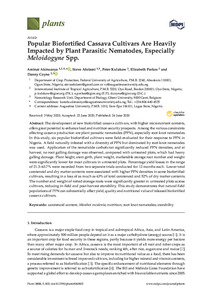| dc.contributor.author | Akinsanya, A. |
| dc.contributor.author | Afolami, S. |
| dc.contributor.author | Kulakow, P. |
| dc.contributor.author | Parkes, E. |
| dc.contributor.author | Coyne, D. |
| dc.date.accessioned | 2022-08-18T08:35:59Z |
| dc.date.available | 2022-08-18T08:35:59Z |
| dc.date.issued | 2020 |
| dc.identifier.citation | Akinsanya, A., Afolami, S., Kulakow, P., Parkes, E. & Coyne, D. (2020). Popular biofortified cassava cultivars are heavily impacted by plant parasitic nematodes, especially Meloidogyne Spp. Plants, 9(6), 802: 1-16. |
| dc.identifier.issn | 2223-7747 |
| dc.identifier.uri | https://hdl.handle.net/20.500.12478/7658 |
| dc.description.abstract | The development of new biofortified cassava cultivars, with higher micronutrient contents, offers great potential to enhance food and nutrition security prospects. Among the various constraints affecting cassava production are plant parasitic nematodes (PPN), especially root-knot nematodes. In this study, six popular biofortified cultivars were field-evaluated for their response to PPN in Nigeria. A field naturally infested with a diversity of PPN but dominated by root-knot nematodes was used. Application of the nematicide carbofuran significantly reduced PPN densities, and at harvest, no root galling damage was observed, compared with untreated plots, which had heavy galling damage. Plant height, stem girth, plant weight, marketable storage root number and weight were significantly lower for most cultivars in untreated plots. Percentage yield losses in the range of 21.3–63.7% were recorded from two separate trials conducted for 12 months each. Lower total carotenoid and dry matter contents were associated with higher PPN densities in some biofortified cultivars, resulting in a loss of as much as 63% of total carotenoid and 52% of dry matter contents. The number and weight of rotted storage roots were significantly greater in untreated plots across cultivars, reducing in-field and post-harvest storability. This study demonstrates that natural field populations of PPN can substantially affect yield, quality and nutritional value of released biofortified cassava cultivars. |
| dc.description.sponsorship | CGIAR Fund Donors |
| dc.description.sponsorship | HarvestPlus |
| dc.description.sponsorship | Bill & Melinda Gates Foundation |
| dc.description.sponsorship | UKAid |
| dc.format.extent | 1-16 |
| dc.language.iso | en |
| dc.subject | Cassava |
| dc.subject | Carotenoids |
| dc.subject | Manihot Esculenta |
| dc.subject | Nutrition |
| dc.subject | Nematodes |
| dc.subject | Keeping Quality |
| dc.subject | Nigeria |
| dc.title | Popular biofortified cassava cultivars are heavily impacted by plant parasitic nematodes, especially Meloidogyne Spp. |
| dc.type | Journal Article |
| cg.contributor.crp | Roots, Tubers and Bananas |
| cg.contributor.affiliation | Federal University of Agriculture, Abeokuta |
| cg.contributor.affiliation | International Institute of Tropical Agriculture |
| cg.contributor.affiliation | Ghent University |
| cg.coverage.region | Africa |
| cg.coverage.region | West Africa |
| cg.coverage.country | Nigeria |
| cg.coverage.hub | Eastern Africa Hub |
| cg.coverage.hub | Headquarters and Western Africa Hub |
| cg.researchtheme | Biotech and Plant Breeding |
| cg.researchtheme | Natural Resource Management |
| cg.identifier.bibtexciteid | AKINSANYA:2020a |
| cg.isijournal | ISI Journal |
| cg.authorship.types | CGIAR and developing country institute |
| cg.iitasubject | Agronomy |
| cg.iitasubject | Cassava |
| cg.iitasubject | Food Security |
| cg.iitasubject | Nutrition |
| cg.iitasubject | Plant Breeding |
| cg.iitasubject | Plant Diseases |
| cg.iitasubject | Plant Production |
| cg.journal | Plants |
| cg.notes | Published online: 26 June 2020 |
| cg.accessibilitystatus | Open Access |
| cg.reviewstatus | Peer Review |
| cg.usagerightslicense | Creative Commons Attribution 4.0 (CC BY 0.0) |
| cg.targetaudience | Scientists |
| cg.identifier.doi | https://dx.doi.org/10.3390/plants9060802 |
| cg.iitaauthor.identifier | Peter Kulakow: 0000-0002-7574-2645 |
| cg.iitaauthor.identifier | E J Parkes: 0000-0003-4063-1483 |
| cg.iitaauthor.identifier | Daniel Coyne: 0000-0002-2030-6328 |
| cg.futureupdate.required | No |
| cg.identifier.issue | 6 |
| cg.identifier.volume | 9 |

